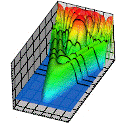Department of Physics and Astronomy: Publications and Other Research
Date of this Version
January 2002
Abstract
High-order harmonic emission is investigated by numerical solution of the weakly relativistic, two-dimensional Schrödinger equation for the case of ultra-intense laser-driven tightly bound systems (for example, multiply charged ions such as O7+ exposed to laser fields of the order of 1018 W cm-2 at 248 nm). In contrast to their usual substantial decrease, the low-order harmonics having an energy less than the ionization potential exhibit a high efficiency (i.e. intense) plateau with a well defined cutoff. The shape of this plateau is found to depend on the shape of the binding potential. A classical “surfing” mechanism for the generation of these harmonics is proposed that does not involve tunneling and that nevertheless explains the observed cutoff. Thus we call them “nontunneling harmonics.” The significance of relativistic effects for these harmonics is investigated and found to be small, despite the high laser intensity, because of the absence of tunneling.


Comments
Published in Journal of Physics B: Atomic, Molecular and Optical Physics 35 (2002), pp. 627–650. Online at http://stacks.iop.org/JPhysB/35/627 Copyright © 2002 Institute of Physics Publishing Ltd. Used by permission.